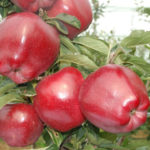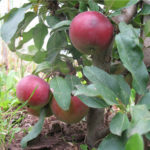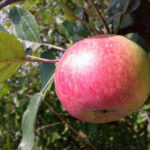Apple variety Pink pearls
Apples with red or pink flesh - if someone hasn't seen it, they've probably heard of them. Some treat such a curiosity with suspicion, suggesting that it could not have done without the ubiquitous GMO. But the first experiments on the selection of such species, and very successful ones, were begun by our remarkable scientist I.V. Michurin. At that time, there was no question of any GMO. It is Michurin who owns the variety Robin, or Suislepskoe, which is still found in the gardens of lovers of this unusual culture. The theme of apples with an atypical flesh color continued to excite the minds of scientists around the world. In the United States, at the very beginning of the twentieth century, breeder Albert Etter from Northern California began his experiments with the aim of creating a new unique variety with red flesh. Old English varieties were taken as a basis, one of which is considered a descendant of the Nedzwiecki apple tree. So in 1944, Pink Pearls appeared, which to this day is considered one of the most popular varieties in this category. At home, this variety is extremely popular among consumers, culinary experts are very interested in it (the unusual pulp inspires them to create haute cuisine masterpieces). In states with mild temperate climates (the coast of California, Oregon, Washington), these apple trees are grown on an industrial scale. Our hero is not included in the State Register of Breeding Achievements of Russia, he has not received widespread distribution on the territory of the country, it is grown mainly by collectors and amateurs who are fond of unusual apple species. According to reports, the tree gets along well in the climate of central Russia.
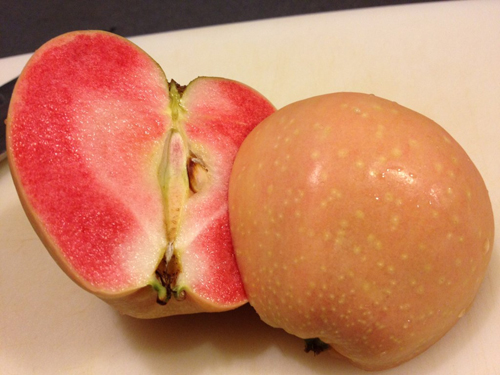
Description
The plant is medium-sized - about 4.5 - 4.8 meters, but if you do not prune on time, the tree can grow over five meters. In the first three years after planting, the growth is about 80 cm, then the annual growth is limited to 50 cm. Annual shoots are light, brown-green. Lentils are small, light, not densely located on the surface of the bark. Leaves of pink pearls are of medium size, elongated-ovate, with a rounded-wedge-shaped base, green in color, venation is weak. The edges of the plate, covered with serrated serration, are raised towards the center; the slightly elongated apex is bent downward. The leaf surface is not pubescent, the reverse side has a lighter shade and slight pubescence. The petiole is of medium length or long, not thick, not colored. Stipules subulate. At the time of flowering, the apple tree looks fantastically attractive due to its abundant flowering. The flowers of the variety are bright, pink, five-petal, saucer-shaped. The petals have a rounded top. Sepals are light, pubescent. The inflorescence has about 5 flowers. The buds are elongated, with a pointed tip, growing, pressing against the shoot. Fruiting occurs on the ringlets and the tops of one-year-old shoots.
The most suitable stock for Pink Pearls is MM-111 (medium or vigorous). It is quite frost-resistant, resistant to major diseases. It is convenient to regulate the growth force of the grafted variety on it.
The fruits of the apple tree are oblong-conical in shape, sometimes with a weakly expressed wide ribbing and a slightly sloping top. Average size, weight about 180 grams. But apples can be small at all - about 70 grams, or, on the contrary, large - up to 350 grams. The funnel is narrow and deep, with traces of rusting. The peduncle is not long, of medium thickness. Shallow saucer, medium width, pleated. The cup is half-open. The sub-cup tube is of medium width, long, connected to the seed nest. Seed nests are small, oblong, heart is wide. The skin is shiny, thin and delicate. The main color of the fruit of this variety is very modest, usually light green, sometimes yellowish, and the illusion is often created that the skin is translucent.The integumentary coat may appear as a slight blurry blush of light crimson. The subcutaneous points are light, clearly visible, cover the surface rather densely, the greatest localization is near the apex.
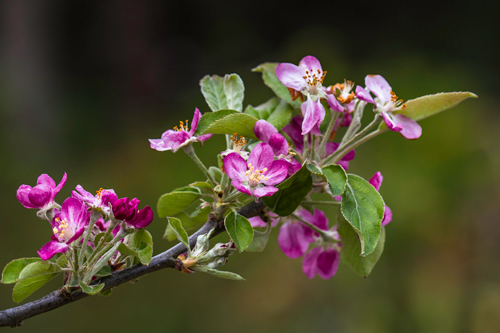
The Pink Pearl fruits are full of surprises for those who are just trying these amazing apples for the first time. Under the unremarkable skin, there is an unusual color and taste of pulp. It has a bright crimson color. In structure, it is quite dense, crispy, fine-grained, very juicy and aromatic. But not only the color of the pulp is surprising, but also the taste. Taste qualities, perhaps, cannot be described unambiguously. The taste is sweet and sour, with astringency, with hints of grapefruit and raspberry. But as American gardeners write, the texture of the pulp, the intensity of its color and taste largely depend on the degree of ripening and seasonal conditions. Red pulp contains a large amount of vitamins A, C and B, pectin and very few calories. That is why this apple tree is so popular in dietary nutrition, especially for lowering cholesterol levels.
Here is how one of the American gardeners who has been growing this variety for quite a long time evaluated the fruits of Pink Pearls on a 10-point scale:
- apple flavor - 7;
- crunch of pulp - 7;
- astringency - 7;
- juiciness - 5;
- sweetness - 5.
Characteristics
- Pink pearls are ranked among early-growing crops, because they are able to bring a harvest in the 3rd year after planting;
- the variety blooms in the early stages. It is self-fertile, therefore, in order to set the maximum number of fruits, as well as improve their quality, other types of apple trees blooming at one time are planted nearby;
- the variety belongs to the early autumn. The crop is harvested in the second decade of September. But the more exact timing is dictated, of course, by the weather, because in favorable years in California, apples were removed from trees even in late August - early September;
- it is difficult to judge the yield, since this information is not available in official sources. But according to some information provided by the distributors of seedlings, the figure is 70 kg per tree;
- on English-language sites, you can find information that the fruiting of Pink pearls is periodic, a productive year can be replaced by a lean one;
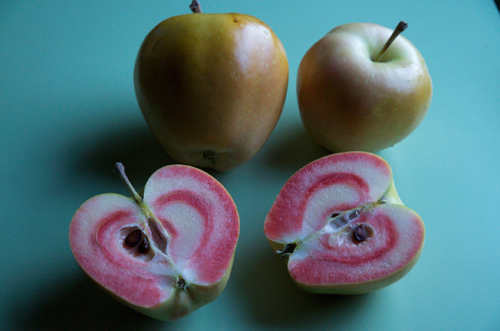
- one of the undoubted advantages of the variety is the non-shedding of fruits. Even ripe apples are firmly attached to the branches, so the harvesting period can stretch for 6 - 8 weeks;
- the immunity of the apple tree is not high enough, since it is known that the culture can suffer from scab and powdery mildew;
- the variety grows well and develops in zones 6 to 9 on the USDA frost resistance scale. This means that at winter temperatures down to -23.3 ° C, the tree does not need winter shelter. There are reports that our hero wintered safely even at lower temperatures, at -30 ° C;
- crop transportability is high. Fruits perfectly tolerate long-distance transportation. But the shelf life is poor. The crop can be stored for a little over a month. Although there is other information - the fruits of this apple tree can be stored for up to 3 months;
- the way of use is universal. Both adults and children are very fond of apples in their natural form, however, the fruits must be fully ripe. Due to its unusual flavor combination, Pink pearls are very popular among culinary specialists. The tart pulp is successfully combined with meat and even fish dishes, it is added to vitamin salads, the sauce prepared from apples of this variety has a velvety structure and is very pleasant to the taste, chips are prepared from apples cut into rings. They also make baked goods, applesauce, cider, jam and sorbet.
Planting and leaving
Pink pearls are planted in autumn and spring.The plant is not very picky about soils, there was information that the plant bore fruit even on clay soils. But it is still better to allocate sunny places with well-permeable and nutritious soil for planting. Loam meets these requirements. The distance between adjacent plants should be about 4 meters. Californian joster, alder and gooseberry are good companions for the variety. It is best to prune an apple tree at the very beginning of spring, until the sap flow has begun. The main goal of the procedure is to eliminate the thickening of the crown by removing branches growing inward, side shoots are shortened by 1/3. Up to 50 liters of water is poured under an adult plant once a month. But you should take into account the weather conditions, for example, if the weather is hot and precipitation is not expected, then the frequency of irrigation can be increased, in rainy weather, on the contrary, reduced, as well as the amount of water. In the spring, you can use nitroammofoska as a top dressing, during the flowering period, wood ash rich in trace elements is used, in the fall - phosphorus-potassium fertilizers.
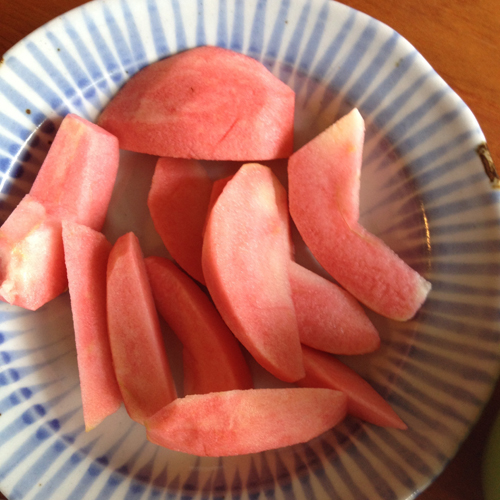
Pink pearls are quite an interesting plant. In spring, it decorates the garden with bright flowering, and in early autumn it presents the gardener with amazing and full of surprises fruits. It is not at all difficult to care for the variety, the main thing is to choose the right place for planting, and then simply carry out agricultural techniques characteristic of the culture. The main value of the variety is the flesh of an unusual color and taste. Indeed, in our garden, there are practically no apple trees with red meat fruits, so for many this variety, no doubt, will be very interesting. Moreover, apples can be consumed not only in their natural form. Due to the fact that the pulp goes well with many products, the hostess will be able to surprise the family and guests with exquisite gourmet cuisine. The disadvantages of the culture are self-infertility and the frequency of fruiting. But it is quite possible to put up with these shortcomings, given the exoticism of the overseas guest.
